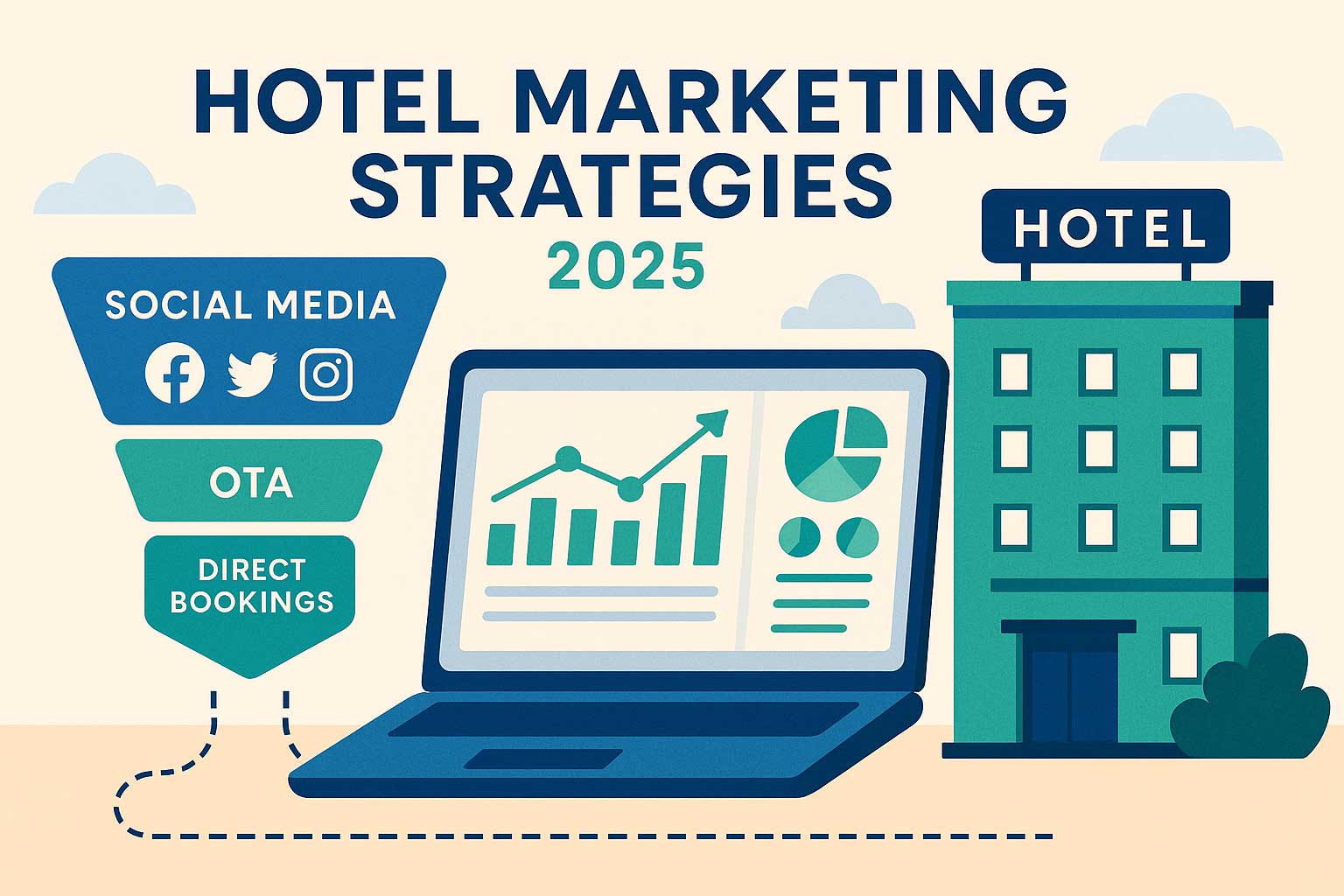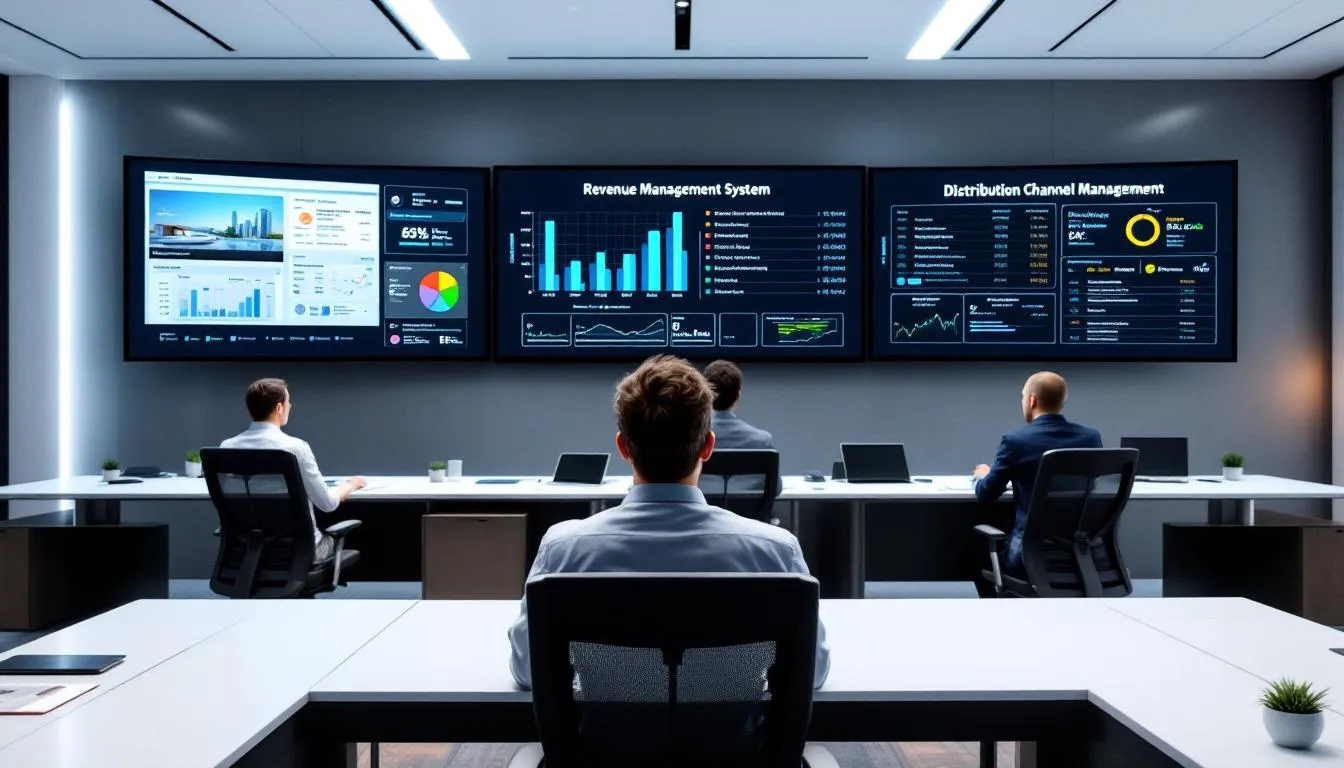Hotel Dynamic Pricing: Complete Strategy Guide for Revenue Optimization
Aug 2, 2025
 Mika Takahashi
Mika TakahashiPopular Categories
Hotel Technology & InnovationHotel Operations OptimizationDigital MarketingIndustry TrendsRevenue ManagementHospitality Industry
Popular Categories
Trending Post

Hotel Walk Letter Template: Professional Guest Communication

Online Travel Agents: What They Are and How They Work

Hotel Security Systems: Modern Protection Solutions

Hotel Advertising: Complete Guide to Boost Bookings and Revenue

25 Hotel Marketing Strategy Ideas for 2025: Complete Guide

AI Reservation Agent: Revolutionizing Hotel Booking and Guest Experience

PMS Communication: Streamlining Property Management Through Effective Guest Messaging
Table of contents
While many hotels still rely on outdated static pricing models, those embracing dynamic pricing often see impressive RevPAR increases of 15-25% within six to twelve months. In today’s fast-paced hospitality industry, the ability to adjust room rates in real time—based on market demand, competitor pricing, and booking patterns—is no longer a luxury but a necessity to maximize revenue.
Hotel dynamic pricing marks a major shift from traditional pricing approaches. It uses advanced algorithms and up-to-the-minute market data to continuously fine-tune room prices, helping your property stay competitive and profitable. This guide will walk you through everything you need to know to implement a dynamic pricing strategy that delivers real results.
What you’ll discover:
- How hotel dynamic pricing works and why it beats static pricing models
- The key market factors that shape smart pricing decisions
- Essential technology platforms and revenue management systems for success
- A step-by-step approach to rolling out dynamic pricing at your hotel
- Best practices to maximize revenue while keeping guests happy
What is Hotel Dynamic Pricing and How Does It Work?
At its core, hotel dynamic pricing is a revenue management strategy that automatically adjusts room rates by analyzing real-time market demand, competitor prices, occupancy levels, and external influences. Unlike static pricing, which locks in rates weeks or months ahead, dynamic pricing tools keep a constant pulse on market conditions, tweaking prices multiple times a day to maximize your hotel revenue.

These dynamic pricing algorithms crunch huge amounts of data, including:
- Historical booking patterns and customer demand data
- Current occupancy rates and reservation pace
- Competitor pricing from nearby hotels
- Market segments and guest behavior trends
- External factors like weather, events, and economic shifts
Dynamic vs Static Pricing: Understanding the Trade-offs
Static pricing offers predictability for your hotel and guests, with rates set based on historical data and seasonal trends. This approach simplifies budgeting and communication but doesn’t allow you to capitalize on sudden spikes in demand or react quickly to market changes.
Dynamic pricing, on the other hand, gives your hotel the flexibility to adapt rates in real time. When demand surges during events or peak seasons, you can raise prices to capture maximum value. When business slows, you can lower rates to boost occupancy and keep revenue flowing.
Take Miami Beach hotels during Art Basel week as an example. Properties using dynamic pricing often increase rates by 40% to match demand, yet still maintain strong occupancy. During hurricane season, those same hotels can quickly reduce prices by 25% to attract more price-sensitive travelers, minimizing revenue loss.
Real-World Dynamic Pricing Examples
Dynamic pricing shines in markets with clear demand fluctuations. Colorado ski resorts, for instance, charge peak prices from December through March when snow draws crowds, then offer discounts in summer to fill rooms during slower months.
Event-driven pricing is another powerful example. When Taylor Swift announces concert dates, hotels within a five-mile radius often see rates double or more for those nights. Properties using dynamic pricing tools capture this surge immediately, while those relying on static pricing miss out on significant revenue.
Key Factors That Drive Hotel Dynamic Pricing Decisions
Getting dynamic pricing right means understanding how multiple market factors interact. Hotel revenue managers analyze these variables to set optimal room prices for different market segments.
Seasonal Demand Patterns and Market Trends
Seasonality is one of the most reliable drivers of hotel pricing. Peak seasons vary widely by location and property type—beach resorts thrive in summer, mountain lodges in winter.
Knowing these patterns helps forecast future demand and set baseline rates. Dynamic pricing takes it further by spotting micro-seasons and subtle demand shifts within peak periods, allowing even finer-tuned revenue management strategies.
Competitor Pricing Strategies and Market Positioning
Competitive pricing analysis is essential for effective dynamic pricing. Revenue management systems track competitor rates from a defined set of comparable properties nearby, considering star ratings, amenities, and target guests.
Your hotel’s market position guides how you price relative to competitors. Luxury properties might price 10-15% above the competition during normal times, while value-focused hotels may set rates 5-10% lower to attract budget-conscious guests.
Rate shopping tools pull competitor pricing from OTAs and direct booking sites, giving revenue managers real-time insights to avoid destructive price wars and maintain a healthy balance between occupancy and average daily rate.
Special Event Impacts and Demand Fluctuations
Local events can cause dramatic spikes in demand. Conferences, sports matches, concerts, and festivals often turn the market upside down overnight. Hotels with advanced demand forecasting can spot these opportunities early and adjust room prices accordingly.
Events can also have ripple effects beyond the immediate area. A big downtown convention might boost occupancy and rates in suburban hotels as overflow guests seek alternatives. Unexpected disruptions like flight cancellations or weather events can create sudden demand surges or cancellations that require quick pricing responses.
Market Segmentation and Guest Behavior Analysis
Understanding your market segments unlocks smarter pricing. Business travelers tend to book Monday through Thursday with 7-14 day lead times and show less price sensitivity due to corporate policies. They often prefer flexible rates and convenient locations near offices.
Leisure travelers usually book weekend stays 60+ days in advance and are more price sensitive, often hunting for discounts well ahead of time.
Group bookings require special pricing strategies, with volume discounts and guaranteed room blocks providing revenue predictability.
Room type preferences also vary: oceanview rooms might command 30% premiums in summer among leisure guests, while business travelers prioritize amenities and location.
Analyzing cancellation and no-show trends helps optimize overbooking. Business travelers may cancel last-minute more often, while leisure bookings tend to be steadier.
Technology and Revenue Management Systems for Dynamic Pricing
Modern hotel dynamic pricing relies on powerful technology platforms that pull data from multiple sources and automate pricing decisions. Choosing the right revenue management system (RMS) and integrating it smoothly with your property management system (PMS) is critical.
Comparing Leading RMS Platforms
Several top RMS platforms cater to different needs:
- Atomize excels in real-time automated rate updates, using machine learning to continuously adjust prices without manual input. It’s great for rapid market response and frequent price changes.
- IDeaS offers deep analytics and scenario modeling, giving revenue managers robust forecasting tools up to 365 days ahead with high accuracy.
- Duetto stands out for flexible pricing rules and seamless integration across distribution channels, allowing customized strategies and smooth PMS and OTA connectivity.
Pricing models vary from flat monthly fees to per-room charges or commissions. Ensure your RMS integrates well with your PMS (like Opera, Protel, or CloudBeds) for automated data sync and real-time inventory management.
Property Management System Integration Requirements
A strong PMS-RMS integration is vital to execute pricing recommendations quickly across all channels. Modern systems connect via APIs that automate data flow, eliminating manual rate updates and reducing errors.
Key integration features include:
- Real-time inventory updates for all room types
- Automatic rate distribution to direct booking engines, OTAs, and GDS
- Synchronization of restrictions like minimum stays or advance purchase rules
- Incorporation of guest data and booking history for personalized pricing

Machine Learning and Demand Forecasting Capabilities
Advanced dynamic pricing tools use machine learning to analyze vast datasets and predict optimal room prices. They digest historical bookings, current reservation pace, competitor pricing, social sentiment, web traffic, and external signals to generate smart pricing recommendations.
Top platforms forecast demand and pricing up to a year ahead with 85%+ accuracy in stable markets. Their algorithms improve over time by learning from past performance and market responses.
Demand forecasting considers booking pace, segment performance, and external factors like weather or event calendars, enabling proactive rather than reactive pricing strategies.
Implementing Dynamic Pricing: Step-by-Step Strategy
Rolling out dynamic pricing successfully means planning carefully, setting clear goals, and integrating it into your hotel’s revenue management processes. Here’s a practical roadmap for transitioning from static to dynamic pricing.
Assessing Current Pricing Strategy Effectiveness
Start by benchmarking your current performance using key hospitality metrics like RevPAR, average daily rate, and occupancy over the past 1-2 years. Compare your results to STR data for your competitive set.
Identify where dynamic pricing could boost results. Hotels losing market share during busy periods may lack pricing agility, while those with low occupancy off-peak might benefit from more flexible rate adjustments.
Map out your existing pricing processes and manual workload. Many hotels spend 20-30 hours weekly on pricing tasks—automation can cut that to just a few hours focused on strategy.
Setting Rate Thresholds and Competitive Analysis
Define minimum and maximum pricing limits to protect brand positioning and guest satisfaction. For example, floors might be set at 70% of rack rate and ceilings at 300% during extreme demand spikes, adjusted to your market and brand.
Choose your competitive set carefully—5-7 properties within a 2-mile radius with similar star rating, amenities, and target guests.
Regularly monitor competitor rates. While RMS platforms automate this, manual checks help validate data and spot opportunities or risks.
Creating Pricing Rules for Different Booking Windows
Tailor pricing rules based on guest booking behaviors across advance purchase windows.
For bookings over 90 days out, offer early booking discounts to capture price-sensitive leisure travelers and improve cash flow.
Between 30-90 days, demand becomes more predictable, so prices can reflect expected market conditions.
From 7-30 days, rates typically rise as inventory tightens and business travelers book.
Last-minute bookings (0-7 days) can command premium pricing when demand is strong or require discounts to fill rooms.
Distribution Channel Optimization
Balance incentives for direct bookings with OTA partnerships while maintaining rate parity.
Offer perks like 5-10% discounts, free breakfast, or Wi-Fi on direct bookings to reduce commissions and build loyalty.
Track channel performance metrics like conversion rates and acquisition costs on platforms like Booking.com vs Expedia.
Adjust marketing spend and rates based on channel profitability and volume.
Consider mobile-specific rates or location-based discounts to capture spontaneous travelers booking last-minute.
Use channel-specific pricing to reflect commission differences while maintaining overall parity.
Benefits and ROI of Hotel Dynamic Pricing
Implementing dynamic pricing delivers benefits far beyond just higher revenue—it also boosts operational efficiency and strengthens your market position.
Quantifying Revenue Improvements
Hotels adopting dynamic pricing typically see 15-25% RevPAR gains within six to twelve months. These come from capturing more demand in peak times and optimizing pricing during slow periods to maximize occupancy and room revenue.
Average daily rates also improve, as prices better reflect real-time market conditions. Many properties report ADR increases of 8-15%.
Revenue growth compounds as machine learning hones forecasting accuracy and hotels refine their strategies based on data.
Operational Efficiency and Time Savings
Automation slashes the time spent on pricing analysis and updates from 20-30 hours a week to just a few hours focused on strategy.
This frees revenue managers to concentrate on market insights, distribution tactics, and enhancing customer satisfaction rather than manual pricing.
Real-time pricing lets hotels react within minutes—not hours or days—to market shifts like weather events or sudden demand spikes, providing a competitive edge.

Competitive Positioning and Market Response
Hotels using dynamic pricing tools gain a clear advantage over those relying on static pricing or manual processes. The ability to update prices multiple times daily ensures you stay optimally positioned relative to competitors and capture demand surges instantly.
Market leaders respond faster to external factors affecting demand, gaining market share during busy periods.
Dynamic pricing also supports consistent brand positioning, ensuring rates reflect your market segment rather than outdated pricing.
Dynamic Pricing Best Practices and Common Pitfalls
Long-term success with dynamic pricing requires balancing revenue goals with guest satisfaction and brand reputation.
Maintaining Transparency and Guest Relations
Be transparent about pricing policies, especially during rapid rate increases, to avoid guest frustration or perceptions of price gouging.
Monitor guest satisfaction and online reviews closely during high-rate periods to ensure perceived value aligns with pricing.
Avoid excessive rate volatility that can confuse guests or trigger OTA algorithm penalties reducing booking visibility.
Avoiding Over-Optimization Traps
Balance short-term revenue gains with long-term loyalty. Aggressive peak pricing might alienate repeat guests or corporate clients.
Regularly review algorithms to ensure pricing decisions make sense to humans, not just machines.
Maintain consistent market positioning across room types and demand periods.
Performance Monitoring and Continuous Optimization
Track key metrics weekly to spot trends and optimization chances: RevPAR index, conversion rates by price point, booking pace by segment and channel.
Review strategies monthly, especially around events or market shifts, to learn what works and what doesn’t.
Use A/B testing to refine pricing for specific room types, segments, or booking windows.
Quarterly algorithm tuning keeps your system aligned with market changes and guest behavior.

Guest Booking Patterns and Behavioral Analysis
Recognize how different market segments respond to price changes. Business travelers usually show lower price sensitivity but expect higher service levels, while leisure guests are more price-aware but flexible on travel dates.
Analyze booking windows to optimize rates: early bookers seek discounts and may accept less desirable rooms, while last-minute guests often pay premiums for convenience.
Use segment-specific cancellation and no-show data to fine-tune overbooking without harming customer satisfaction.
Conclusion
Hotel dynamic pricing is a game-changing approach to revenue management that boosts both occupancy and profitability. Hotels adopting advanced dynamic pricing strategies consistently outperform those using static models, seeing 15-25% RevPAR improvements while cutting manual workload by up to 90%.
But success goes beyond technology—it requires strategic thinking about your market position, guest experience, and brand reputation. Hotels that balance aggressive revenue optimization with transparency and customer satisfaction build sustainable competitive advantages that grow over time.
The hospitality industry is evolving toward real-time personalization and responsiveness. Hotels mastering dynamic pricing today will be best positioned to leverage future innovations in AI, predictive analytics, and guest-specific pricing.
Start your dynamic pricing journey by assessing your current revenue management processes, exploring RMS platforms that fit your needs, and conducting competitive analysis to uncover new opportunities. The hotels that act decisively will capture market share and revenue growth, leaving competitors behind still stuck in the past.
